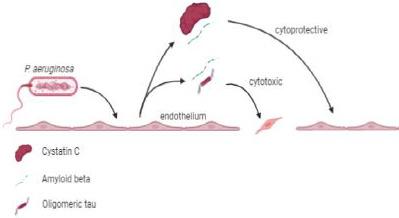当前位置:
X-MOL 学术
›
FEBS Open Bio
›
论文详情
Our official English website, www.x-mol.net, welcomes your
feedback! (Note: you will need to create a separate account there.)
Cystatin C regulates the cytotoxicity of infection‐induced endothelial‐derived β‐amyloid
FEBS Open Bio ( IF 2.8 ) Pub Date : 2020-10-08 , DOI: 10.1002/2211-5463.12997 Ron Balczon 1, 2 , Kyle A Morrow 3 , Silas Leavesley 2, 4 , Christopher M Francis 2, 5 , Trevor C Stevens 2, 5 , Ezinne Agwaramgbo 5 , Christopher Williams 6 , Reece P Stevens 2, 5 , Geri Langham 5 , Sarah Voth 2, 5 , Eugene A Cioffi 7 , Susan E Weintraub 8 , Troy Stevens 2, 5
FEBS Open Bio ( IF 2.8 ) Pub Date : 2020-10-08 , DOI: 10.1002/2211-5463.12997 Ron Balczon 1, 2 , Kyle A Morrow 3 , Silas Leavesley 2, 4 , Christopher M Francis 2, 5 , Trevor C Stevens 2, 5 , Ezinne Agwaramgbo 5 , Christopher Williams 6 , Reece P Stevens 2, 5 , Geri Langham 5 , Sarah Voth 2, 5 , Eugene A Cioffi 7 , Susan E Weintraub 8 , Troy Stevens 2, 5
Affiliation

|
Infection of rat pulmonary microvascular endothelial cells with the bacterium Pseudomonas aeruginosa induces the production and release of cytotoxic oligomeric tau and beta amyloid (Aβ). Here, we characterized these cytotoxic amyloids. Cytotoxic behavior and oligomeric tau were partially resistant to digestion with proteinase K, but cytotoxicity was abolished by various denaturants including phenol, diethylpyrocarbonate (DEPC), and 1,1,1,3,3,3‐hexafluoro‐2‐isopropanol (HFIP). Ultracentrifugation for 8 h at 150 000 g was required to remove cytotoxic activity from the supernatant. Ultracentrifugation, DEPC treatment, and immunodepletion using antibodies against Aβ also demonstrated that cytoprotective protein(s) are released from endothelial cells during P. aeruginosa infection. Mass spectrometry of endothelial cell culture media following P. aeruginosa infection allowed identification of multiple potential secreted modulators of Aβ, including cystatin C, gelsolin, and ApoJ/clusterin. Immunodepletion, co‐immunoprecipitation, and ultracentrifugation determined that the cytoprotective factor released during infection of endothelial cells by P. aeruginosa is cystatin C, which appears to be in a complex with Aβ. Cytoprotective cystatin C may provide a novel therapeutic avenue for protection against the long‐term consequences of infection with P. aeruginosa.
中文翻译:

胱抑素 C 调节感染诱导的内皮源性 β-淀粉样蛋白的细胞毒性
铜绿假单胞菌感染大鼠肺微血管内皮细胞会诱导细胞毒性寡聚 tau 蛋白和 β 淀粉样蛋白 (Aβ) 的产生和释放。在这里,我们表征了这些细胞毒性淀粉样蛋白。细胞毒性行为和寡聚 tau 蛋白对蛋白酶 K 的消化有部分抵抗力,但细胞毒性被多种变性剂消除,包括苯酚、焦碳酸二乙酯 (DEPC) 和 1,1,1,3,3,3-六氟-2-异丙醇 (HFIP) 。需要在 150 000 g下超速离心 8 小时,以去除上清液中的细胞毒性活性。超速离心、DEPC 处理和使用抗 Aβ 抗体的免疫耗竭也表明,在铜绿假单胞菌感染期间,内皮细胞会释放细胞保护蛋白。铜绿假单胞菌感染后的内皮细胞培养基的质谱分析可以鉴定多种潜在的 Aβ 分泌调节剂,包括半胱氨酸蛋白酶抑制剂 C、凝溶胶蛋白和 ApoJ/簇蛋白。免疫耗竭、免疫共沉淀和超速离心确定铜绿假单胞菌感染内皮细胞期间释放的细胞保护因子是胱抑素 C,它似乎与 Aβ 形成复合物。细胞保护性半胱氨酸蛋白酶抑制剂 C 可能提供一种新的治疗途径,以预防铜绿假单胞菌感染的长期后果。
更新日期:2020-11-04
中文翻译:

胱抑素 C 调节感染诱导的内皮源性 β-淀粉样蛋白的细胞毒性
铜绿假单胞菌感染大鼠肺微血管内皮细胞会诱导细胞毒性寡聚 tau 蛋白和 β 淀粉样蛋白 (Aβ) 的产生和释放。在这里,我们表征了这些细胞毒性淀粉样蛋白。细胞毒性行为和寡聚 tau 蛋白对蛋白酶 K 的消化有部分抵抗力,但细胞毒性被多种变性剂消除,包括苯酚、焦碳酸二乙酯 (DEPC) 和 1,1,1,3,3,3-六氟-2-异丙醇 (HFIP) 。需要在 150 000 g下超速离心 8 小时,以去除上清液中的细胞毒性活性。超速离心、DEPC 处理和使用抗 Aβ 抗体的免疫耗竭也表明,在铜绿假单胞菌感染期间,内皮细胞会释放细胞保护蛋白。铜绿假单胞菌感染后的内皮细胞培养基的质谱分析可以鉴定多种潜在的 Aβ 分泌调节剂,包括半胱氨酸蛋白酶抑制剂 C、凝溶胶蛋白和 ApoJ/簇蛋白。免疫耗竭、免疫共沉淀和超速离心确定铜绿假单胞菌感染内皮细胞期间释放的细胞保护因子是胱抑素 C,它似乎与 Aβ 形成复合物。细胞保护性半胱氨酸蛋白酶抑制剂 C 可能提供一种新的治疗途径,以预防铜绿假单胞菌感染的长期后果。











































 京公网安备 11010802027423号
京公网安备 11010802027423号